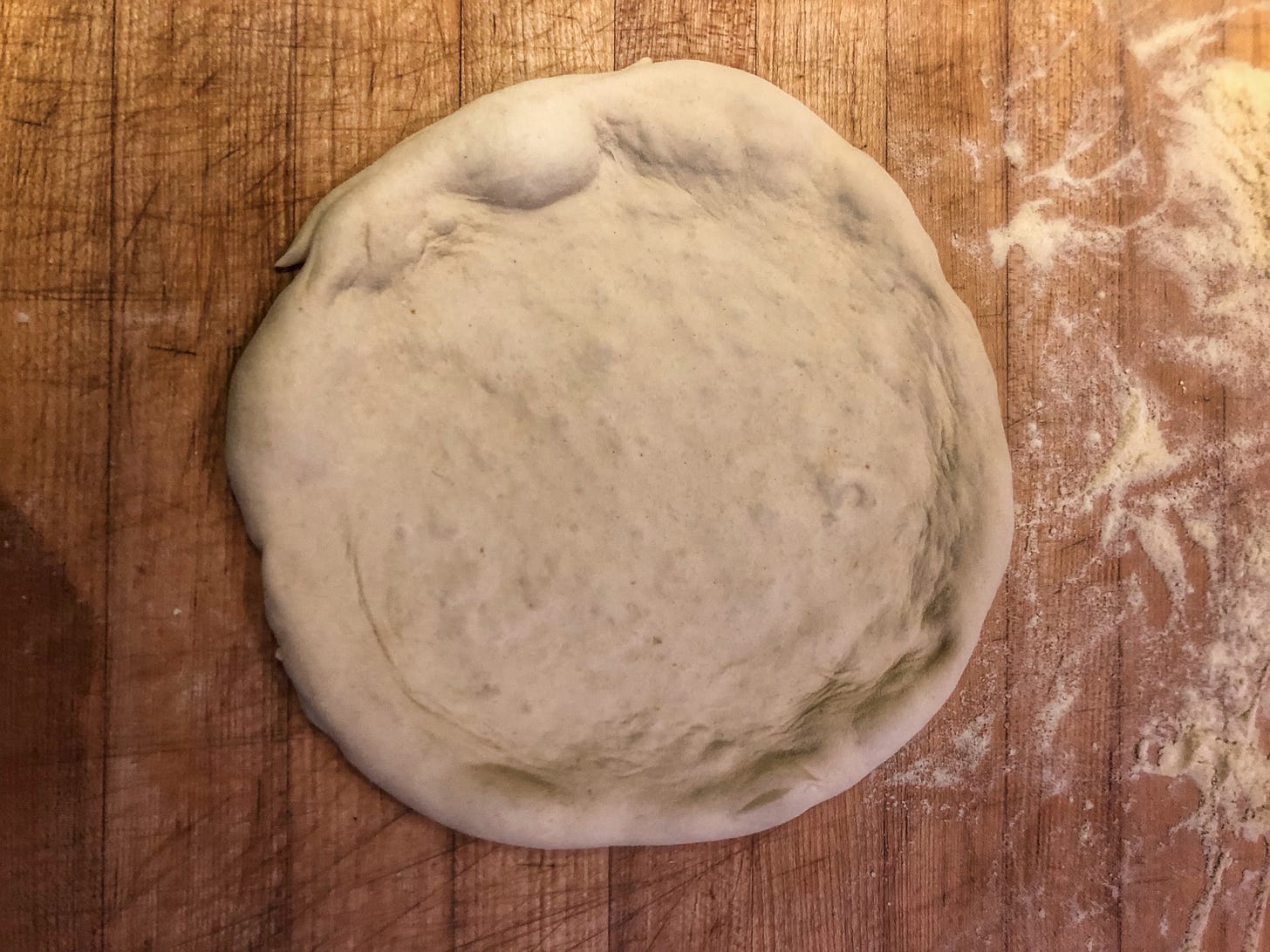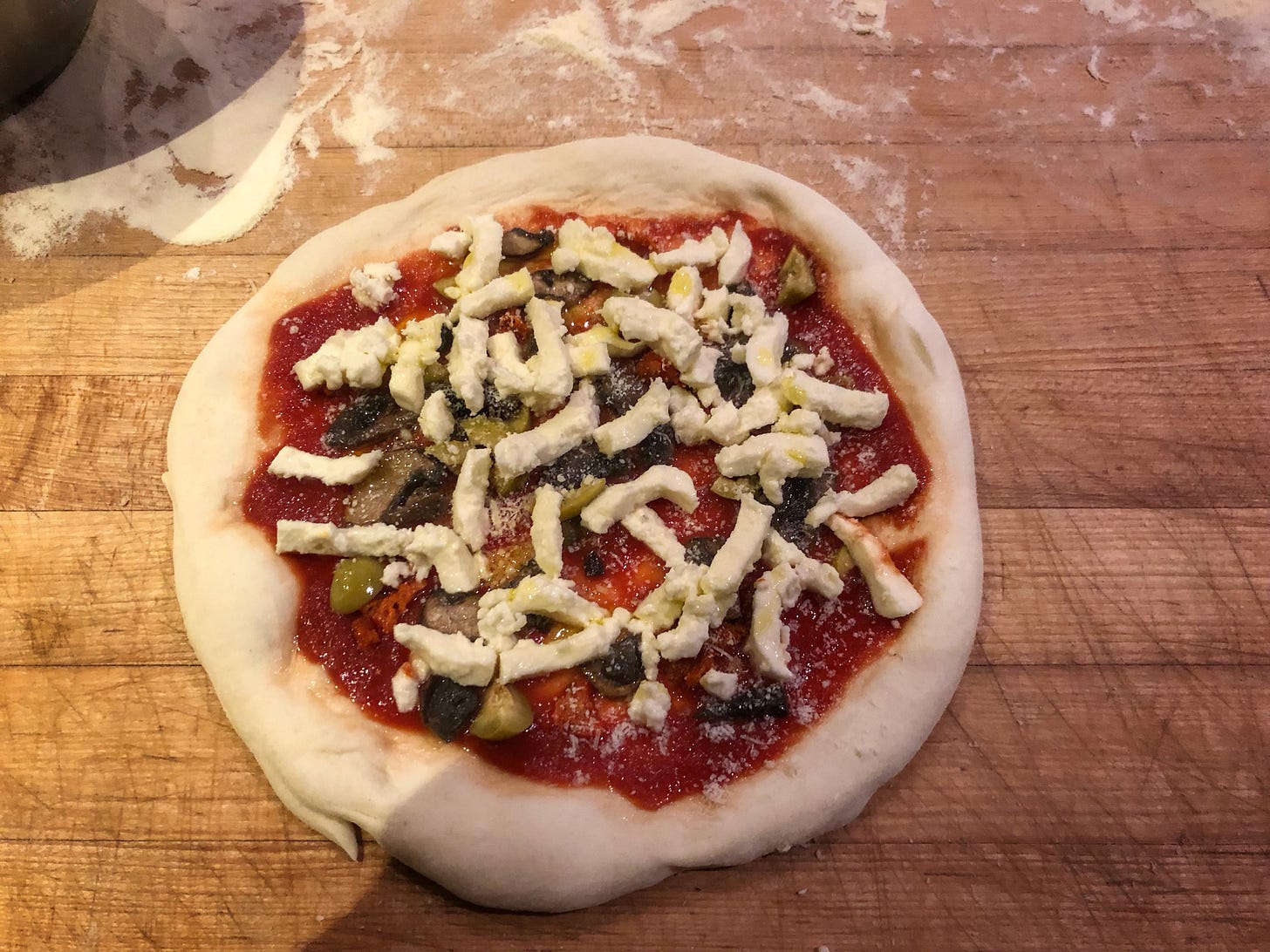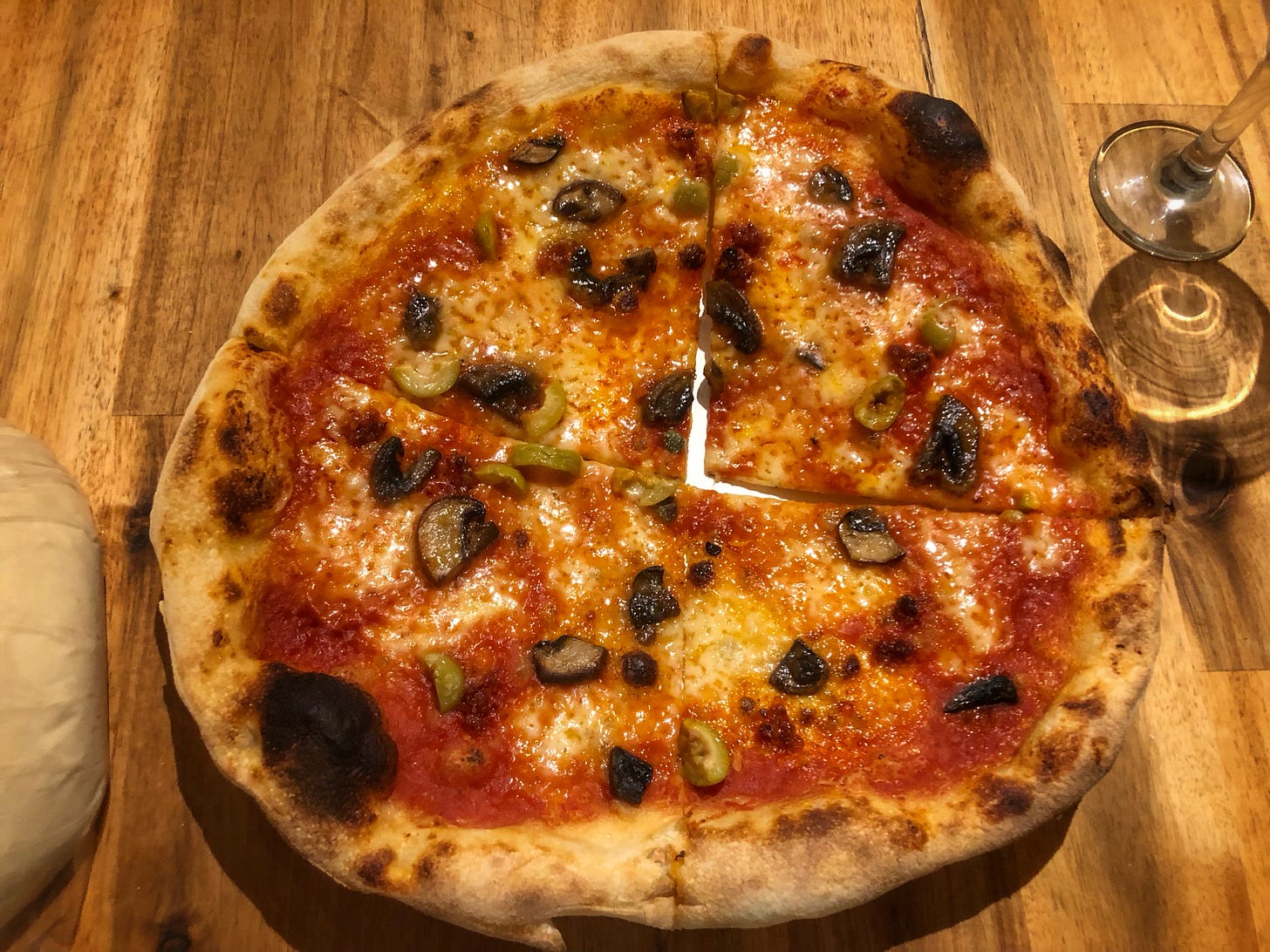35. No More Tears
When you can't YouTube your way out of a problem
Hello again. There hasn’t been a new Plate Cleaner issue in a while because I was waiting until I was able to write a good ending to this story. I spent most of the summer suffering from the yips. But it wasn’t my putting ability1 or my throws to first base that were affected. I suffered from the culinary yips: I lost the ability to make pizza. Like so many middle-aged men, I got my first backyard pizza oven near the beginning of the pandemic2 and over the years my pizza making skills have, in fits and starts, gotten quite decent.3 But it seemed like one day this summer I was able to stretch a dough ball into a round pie of uniform thickness with a well proportioned crust4 and the next day I couldn’t.
To stretch a pizza dough, you start by flattening a dough ball, forcing the gas that’s puffed it up towards the edge, forming the crust. Once you have a small, flat round disk, you begin stretching it out to its full diameter and uniform thinness. Most times, my dough would remain thick in some places and so thin in others it would tear. Tears when stretching can usually be fixed, but they’re almost always signs of problems to come. If part of the dough is thin enough to tear during stretching, it’s obviously in danger of tearing while being moved in, around, or out of the oven, which can result in anything from a bit of a mess to an all-out disaster. It’s also easy for the moisture from tomato sauce to soak through a thin spot in a dough, causing the bottom of the pizza to stick to the peel, making it difficult or impossible to launch into the oven.
One way of avoiding tears is not to stretch the dough much. The resulting pizzas, though, will have thick bases that are difficult to cook through without burning everything else. The crusts will be dense and doughy and take up too much of the pizza’s overall area, leaving less than idea space for toppings. People often say there is no bad pizza, but they’re wrong. This was bad pizza. Sure it tasted good but, to paraphrase Joe Rosenthal, who wrote the most complete guide to making great New York-style pizza at home, you can put all of a pizza’s components in a bucket and it will taste good. That doesn’t make it good pizza.
Making pizza, which I was doing because it was supposed to be fun, was now a source of anxiety. As soon as I picked up a dough ball, my hands started to shake, certain that it was going to end badly. I wanted to power through my current problems, but at the same time dreaded each time I planned to make it again.
I thought I could figure it out by myself. The problem could lie in either how I was making the dough or how I was stretching it (or both). I hunkered down with a bunch of YouTube videos and, in order to isolate a single variable, two pounds of store-bought dough. I could barely start stretching without the dough starting to tear. I had hit bottom. I was confused and demoralized. And with every video I watched, I had more and more unanswered questions. It was clear I needed in-person help.
A quick search for “Toronto pizza classes” turned up a fair number of options of varying intensities. I didn’t need to learn the ins and outs of running a pizza business, so enrolling at the The School of Italian Pizza seemed like overkill. The Homemade Pizza Class at Cucinato Italian Culinary Studio seemed to be what I was looking for. It was taught by a chef from Naples, a single streetcar ride away, and, most importantly, only two weeks away. Soon enough to still have some summer pizza-making left, but just distant enough that I could at least partly forget the sting of my recent failures.
One thing I hadn’t considered about non-business-oriented pizza classes is that they are about socializing as they are about making pizza. I was the only singleton among couples on dates, families, and teams of co-workers. While they were there to have a good time and do some bonding, I was there with a Serious Pizza Purpose.5
I’m sure I came across a bit oddly to my classmates: alone, hyper-focused on everything the chef was showing us, and clearly already capable of mixing and kneading dough. They had come to learn all the steps to making a pizza from square one; I was there to work out one specific hitch.
Fortunately, Chef Alessandro Pagano, a pizzaiolo certified by the Associazione Verace Pizza Napoletana, was able to help both me and my classmates. He’d patiently show the other students how to scrape down their mixing bowls, so all of their flour got incorporated, and then put up with me showing him photos of past doughs I’d made in the past, speculating as to why they might have failed. Mark, the owner of Cucinato, was also great at engaging me during the periods when the Chef Alessandro was helping the others.
After mixing our dough ingredients, kneading and shaping them into a ball, we were ready to learn about shaping and stretching. Using dough that had been made earlier—dough needs time to develop gluten and to ferment in order to develop flavour—we learned about the Neapolitan Slap method6 of stretching, a much gentler technique than the “record player” style I had seen in so many videos.
The first big breakthrough for me came with a new order for doing things. I had been stretching my dough to my desired size (or as close to it as I could get), then placing it on my peel and adding toppings. Chef Alessandro had us stretch the dough only part way to its full size and then add toppings while the dough was still on the counter. I think this change was a key.
The more a dough is worked, the more its gluten stiffens up, resisting stretching and even shrinking back. This resistance can easily lead to tearing. By only stretching the dough a bit and then topping it, the dough has down time for the gluten to relax and become more extensible again. After topping, Chef Alessandro gave the once again stretchy dough a final big pull to full size before turning it over to me to transfer to the peel and launch into the oven.
When the pizza came out of the oven, it was hard to believe I had a hand in making it. The crust was crisp and incredibly thin. The edges of the crust were light and puffy, as opposed to the dense edges I had become used to. From a technical perspective easily the best pizza I had ever made. Sometimes, it seems, it’s OK to admit you can’t fix everything by yourself.
I was buoyed by my success, but I knew it meant nothing if I couldn’t repeat it at home without Chef Alessandro to keep me on course. A few days later, using the dough I’d made in class and kept in the fridge to ferment, I got to work. There was enough dough for three 12-14” pies. The first two were on the smaller end of that range, possibly a little under, but neither felt like they were in any danger of tearing and they looked so much better than what I had been making before the class. The final pie, though, was one that I am especially proud of. Probably because it had sat out the longest and warmed up completely, I was able to stretch the dough to almost the full 14”. It was just slightly less than perfectly circular, but it was definitely the best dough I’d stretched on my own.
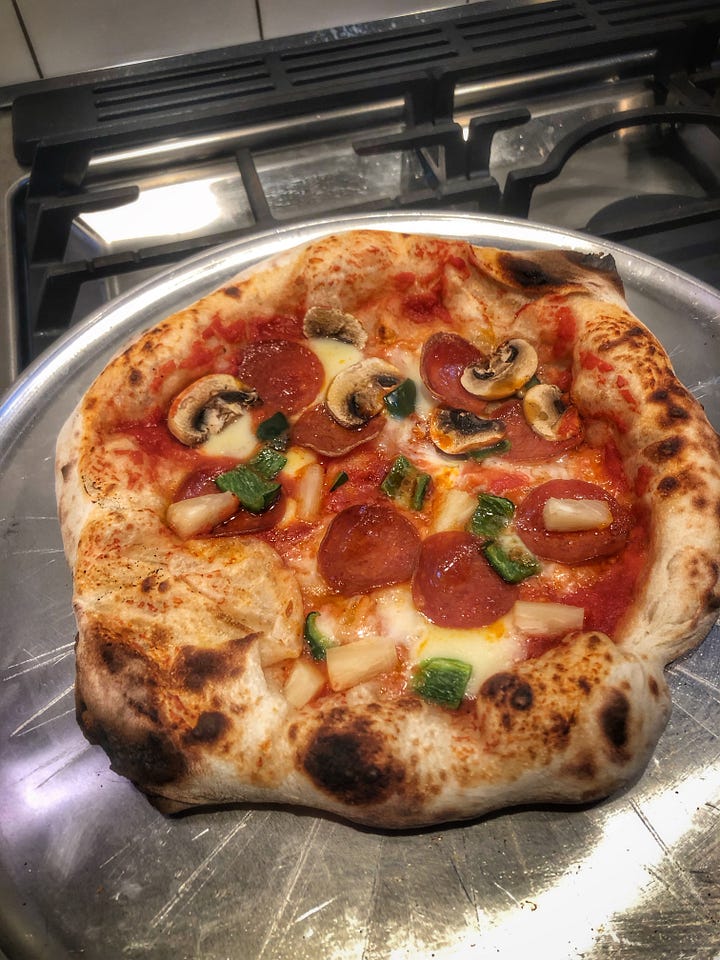
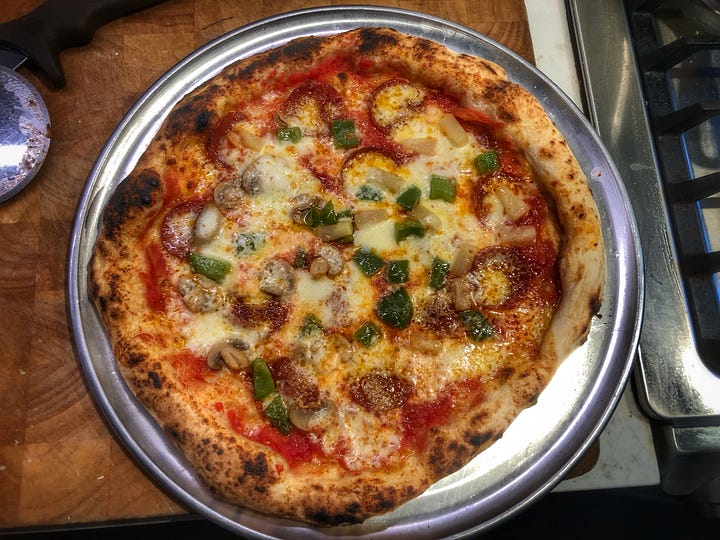
I’ve made pizza again since, using dough that I prepared completely free of supervision. It wasn’t quite as good as the pie I made in class or the third pie I made at home, but it is far, far better than what I was making before and, even more importantly, I’m enjoying making it again. And that will keep me making it and, hopefully, getting better and better at it.
(And if this has piqued your interest in making pizza at home, Cucinato has another class scheduled for the end of September.)
What I’m consuming…
While I’m writing in my piddly little newsletter about how trying to learn to make pizza online was no substitute for thoughtful in-person instruction, Beth was writing (more thoughtfully) about the importance of thoughtful in-person instruction (among many other things) in The Globe and Fucking Mail.7
Last weekend I stumbled upon a huge two-tiered cast aluminum steamer at a thrift shop north of Maynooth. I think it cost $12. Until now I’ve always had to make do with either a bamboo steamer or the little metal basket in my Instant Pot. I’m very eager to see the many ways I can put it to use and will be digging into as many sources as I can for ideas, including the steaming sections in Shizuo Tsuji’s Japanese Cooking: A Simple Art. I’ve also been loving tamales lately, so I will probably start devouring some tutorials on how to make them as well.
What’s on the menu…
Acid League vinegars. My sister turned me on to this brand of inventive and inspired vinegars from Guelph, specifically their Garden Heat, which is not particularly spicy but somehow evokes a perfectly ripe tomato. They’re great but they’re not cheap—a bottle of Garden Heat goes for $21 on their website, though I’ve seen other bottles in stores for $10 or so. Imagine my delight when, on a visit to the Grocery Outlet8 I found shelves full of a bunch of different Acid League flavours including Garden Heat for $3.99 each. (Or $2 if you don’t mind bottles that are near or past their best before date.)
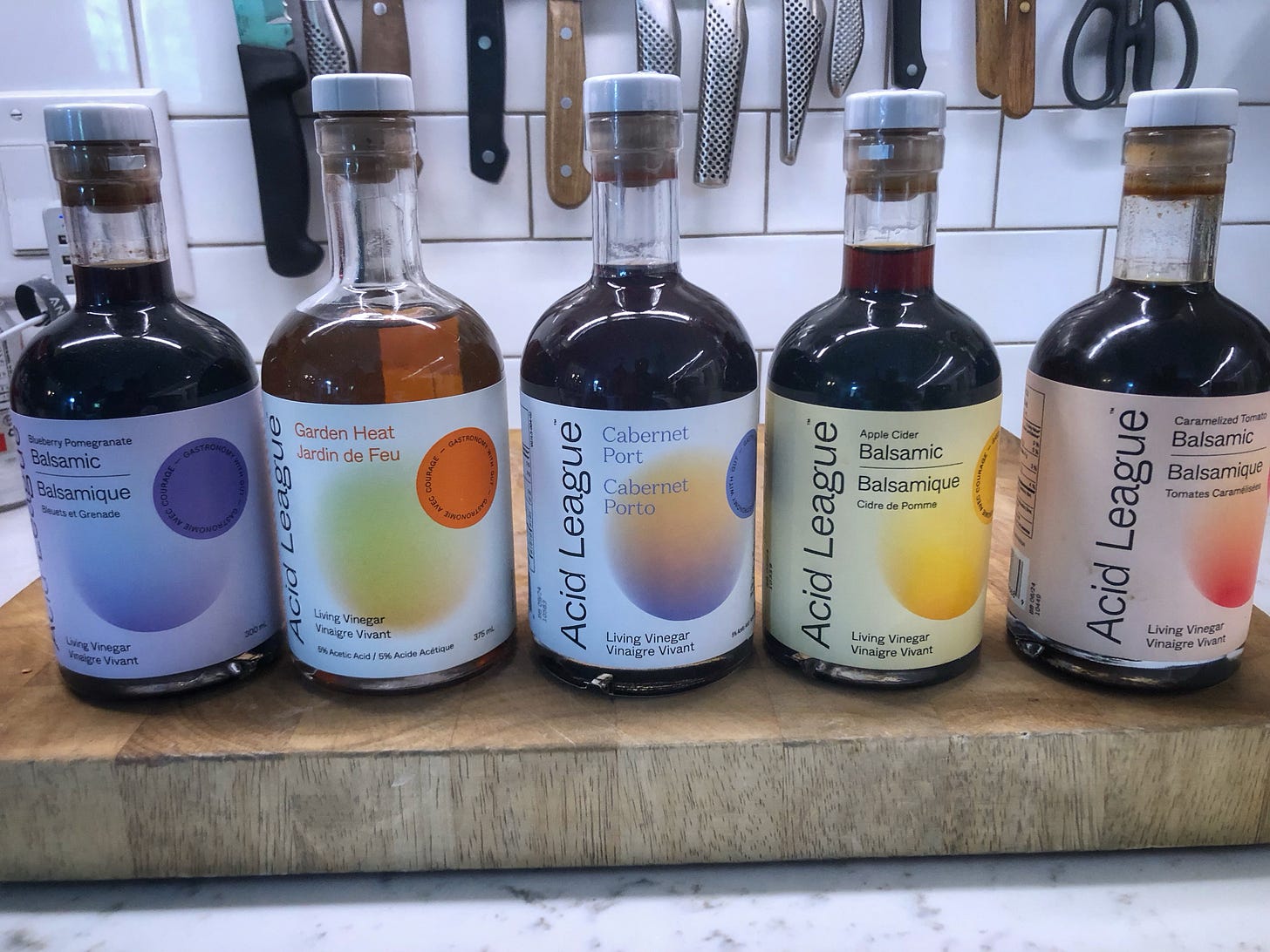
From L to R: Blueberry Pomegranate Balsamic, Garden Heat, Cabernet Port, Apple Cider Balsamic, Caramelized Tomato Balsamic. There was a Medjool Date Balsamic as well, but I gave it to my sister. There are many other varieties out there, but this is the $3.99 selection. With a deal like this, I instinctively grabbed a several bottles of each so my sister and I could each have a stockpile. Since then, I have seen several huge shelves loaded with bottles at other Grocery Outlet locations, so there’s probably no need to hoard them. At least until this note sets off a land rush for them.
Corn and tomatoes, of course. Beth’s and my anniversary is August 21, smack dab in the middle of both corn and tomato season. For the last few years, we’ve celebrated with a build-your-own-BLT bar followed by boiled corn. But because BLTs and corn are their own reason for celebrating, we’ve had the same meal several more times since then.
Yakitori. Because getting a handle on making pizza isn’t enough of a task, this summer I’ve also started trying to make yakitori, Japanese skewered grilled chicken, as well. For a beginner it doesn’t have quite the same learning curve as pizza, fortunately.
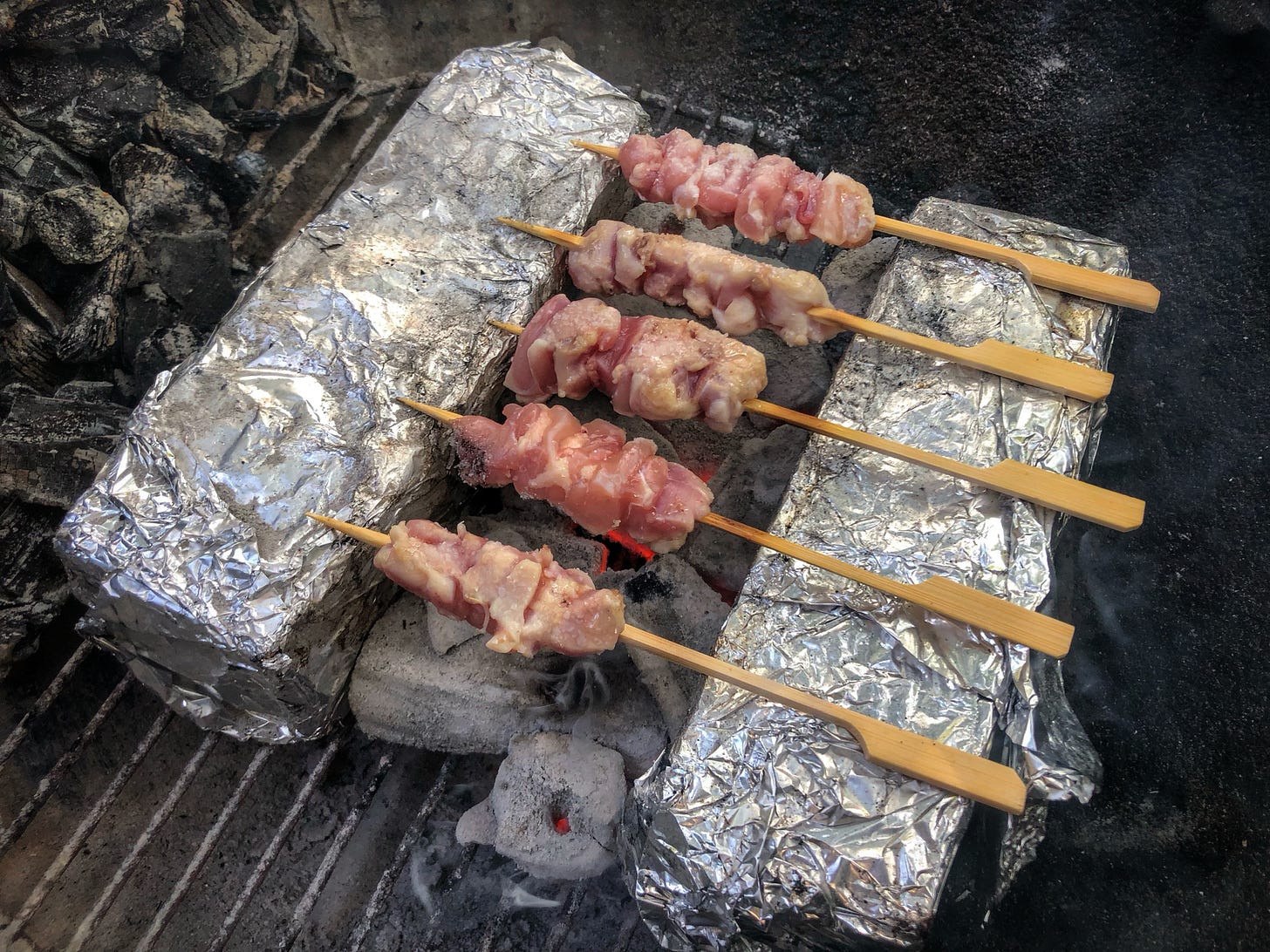
Sure you can spend hundreds of dollars on a ceramic Konro grill, but you can also wrap a couple of bricks in foil. The chicken can’t tell the difference. I had been eyeing the paddle skewers and binchotan-style charcoal, among other things, at Knifewear, a store in Ottawa (and other locations) that specializes in Japanese knives but also carries a range of yakitori equipment. I was about to take the plunge and fill up my cart with $100 of things to get free shipping when I noticed that they had opened a Toronto location a few weeks earlier. As an added bonus, it’s just a short detour on my way to get groceries. This is both very convenient and very dangerous.9 I have found other stores specializing in Japanese knives can be a bit cold and intimidating, but the staff at Knifewear were extremely welcoming and approachable.
It’s as terrible as it has always been. (I assume. The last time I played golf was in 2007.)
I also started a Substack newsletter. How much of a cliche am I?
That I have improved at all is kind of surprising considering I might make two to three pizzas maybe three times a month, which works out to around 350 or so pizzas in that time. Or what a professional probably makes in between a day and a week.
Technically the crust is the entire disc of dough and the raised edge is called the cornicione, but I’ll curb my prescriptivism here.
Like the villain in a reality TV show, I literally wasn’t there to make friends. And to vanquish my enemy: torn dough.
I am nowhere near as fast as the chef in that video, but I’m getting there.
But could she swear in her piece? Because I fucking well can.
The Grocery Outlet should probably get its own issue. Great deals on overstock from other stores. It’s like Winners for food. There’s always at least one surprise per visit.
Suffice it to say, I would have gotten free shipping.



